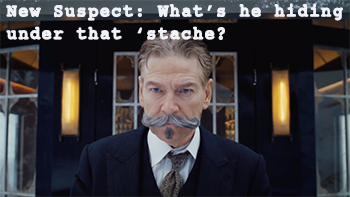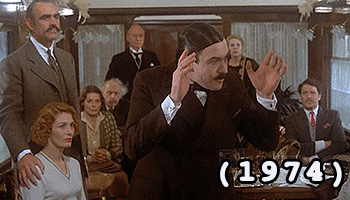I grew up during the young days of VHS recordings. My family lived in Tokyo at the time and we recorded many English language movies off TV, and the 1974 version of Murder on the Orient Express was one we watched over and over.
So I was eager to see how the new version stacked up.
 It doesn’t.
It doesn’t.
Its failure is informative to writers. Yes, the mustache is its own character, and Poirot is nauseating with his “only God and Poirot know” and “I’m the greatest detective in the world” schtick. But that’s not why the story isn’t satisfying.
NOTE: I haven’t read Agatha Christie’s original, so this analysis is only from a story development perspective. And yes:
*** SPOILERS ABOUND ***
The Opening
The first thing we notice about MOTOE 2017 is that it begins far from the Orient Express in Jerusalem, where Poirot solves the mystery of the missing artifact. It’s a superhero intro, meant to prove to the audience that he’s indeed the “greatest detective in the world” by showing his process and moral code before we shoehorn him into the story’s true battle.
But here’s the thing, writers: if your actual story is compelling, we don’t NEED that intro. A few lines of passengers remarking on the famous detective is all it requires.
What you really need is an opening that engages the audience while you’re setting up the murder. Something like the exotic nature of the Orient Express through the passengers’ perspective, something that establishes their characters in conflict under Poirot’s all-seeing-eye. Remember, few people take the OE, so begin with travelogue.
Hit your Act One Marks!
The murder is discovered 38 minutes into the movie. Ratchett asks for Poirot’s help at 30 minutes.
The murder SHOULD have been discovered around 25 minutes, where the act one climax belongs.
The movie isn’t called “Journey on the OE” but “MURDER on the OE.” We know the murder is coming, so don’t make the audience WAIT for it.
One daring writer might put it at the incident incident (~page 10) if we can establish the protagonist and victim effectively before then. That’s ideal, because that locks the audience into the mystery early. Then the act one climax can be the avalanche trapping everyone together.
But, since you have a bunch of suspects and Poirot intro, a murder/avalanche at the act one climax is reasonable, but don’t make us wait.
Rachett should have asked for help at the ten minute mark, off the train or on.
As is, at 10 minutes, Poirot’s conversation with Mary the governess doesn’t “upset the apple cart.”
The Villain(s) Plan
Any great murder mystery requires a brilliant murder plot. The villain’s plan is the foundation upon which the success of the story lies. This one is famous – the 12 stab wounds on an isolated train, so the way you cover your tracks is vital to a fun tale.
For the murderer, the problem is: once you learn Poirot is on the train, and you’re still committed to the deed, how do you create enough misdirection to get away with it?
This is something MOTOE 2017 attempts to do but doesn’t fully develop. Yes, we misdirect with the missing clothes, and stab Michelle Pfeiffer (well played!), but honestly, once we learn everyone is tied to Daisy Armstrong and no one has any conflicts among each other, it’s fairly obvious who did it from the number of stab wounds. That’s our real problem.
Instead, we need two things:
1. A plausible alternative solution
That is, the lone mafia stabber that fled the train. We need clues that lead AWAY from the current train occupants.
What if one of them fled the train to provide footprints? Then you have a sequence of Poirot the bloodhound following the footprints in the snow until he sees them possibly return to the train just as rescue crew shows up to obscure the tracks.
That creates doubt. Then all you need is a few crewmen who look suspicious, and repeated mafia references among the other suspects and you have a great stinky red herring.
2. Interpersonal Conflicts to Distract from the Obvious
That is, conflicts among the passengers that create possible motives other than the Armstrong case.
The current character set ups provide other conflict: the hidden interracial romance between governess and doctor. Have Poirot notice it first (as we did), then have Ratchett notice, and cause conflict in the dining car among the others before the murder.
In addition, create an argument over a card game and drinks. This steals from The Sting, and it always works. Have Ratchett realize that he’s a mark and accuse others of cheating, and he’s going to get to the bottom of it.
In other words, before the murder, give us stronger reasons to kill Ratchett than people don’t like his face or his voice.
The Villain(s) AFTER Plan
After the murder and they’re struck in the snow for what may be days, have the villain(s) device an alternate reality for Poirot, not just with stabbing Pfeiffer, but a series of things that preserve the lone killer theory.
Since so many are actors in this drama, so they should really concoct a play to keep Poirot running.
Currently, the individual lies fall away but nothing takes their place. For example, Hardman is shown to be a Pinkerton agent, then the old cop on the Armstrong case. Fine, but what if that guy was also conspiring with Hector to cheat Ratchett and cook the books? Or if Hardman says Hector feared Ratchett finding out about the cooked books and asked him to off Rackett, which he refused.
Offering that information to Poirot defuses Hardman momentarily as a suspect while creating another misdirection about Hector seeking someone to kill Rackett on the greed motive, not the Armstrong case.
All to say, don’t make the obvious too obvious.
If you need more ideas, watch Witness for the Prosecution.
In the third act, we watch each character break, reveal their guilt, and melodramatically react. The doctor shooting Poirot and confessing is the worst example because it creates complications and action, but it doesn’t develop. He’s not shown in chains as the martyr to the cause, but put back with the others.
I’m pretty sure anyone who shoots Poirot is going to jail, reasons or not.
The Moral Problem
 The 1974 version has Sean Connery explain to Poirot that “12 men, tried and true, is a sound system.” In other words, a jury with the facts are most qualified to determine guilt, not a vigilante or mob.
The 1974 version has Sean Connery explain to Poirot that “12 men, tried and true, is a sound system.” In other words, a jury with the facts are most qualified to determine guilt, not a vigilante or mob.
Note: THAT is why there are 12 stab wounds!
Then, at the reveal, no one confesses, and Poirot provides two alternatives, saying that the police will like the simplicity of the lone killer theory. That is, Poirot gives BOTH theories to the cops, knowing that they will reject the idea of 12 killers offing the guy.
That’s the moral compass in the 1974 version. It upholds the virtue of the law while ironically showing its weakness. After all, how can a justice system that let Ratchett go possibly convict all of them on this circumstantial evidence?
 In MOTOE 2017, Poirot gets maudlin confessions we already understand, and orders them to kill him too, before deciding to “listen to his heart.” He says the police accepted his first solution, the lone killer theory, but doesn’t say he gave them both theories.
In MOTOE 2017, Poirot gets maudlin confessions we already understand, and orders them to kill him too, before deciding to “listen to his heart.” He says the police accepted his first solution, the lone killer theory, but doesn’t say he gave them both theories.
And moral conscience is “burned with Daisy”? There’s “right and wrong, and then there’s you”?
That morality is as empty as the gun. What he’s expressing in true millennial fashion, is that feelings trump the law, and the truth, if your heart says so.
More than anything else, this is why the movie fails. We know that society CANNOT accept this empty-headed morality. The law, flawed as it is, must stand.
Pain and grief may compound, and indeed needs a chance to heal, but Poirot doesn’t have the right to decide what is the “truth for himself.”
There is no such thing as individual truth, only opinions, and excuses.
Why? Because “your truth” is fallible. Watch Witness for the Prosecution!
What the Murder on the Orient Express was designed to do was to challenge and then restore the moral order. This one didn’t.
Thoughts?
